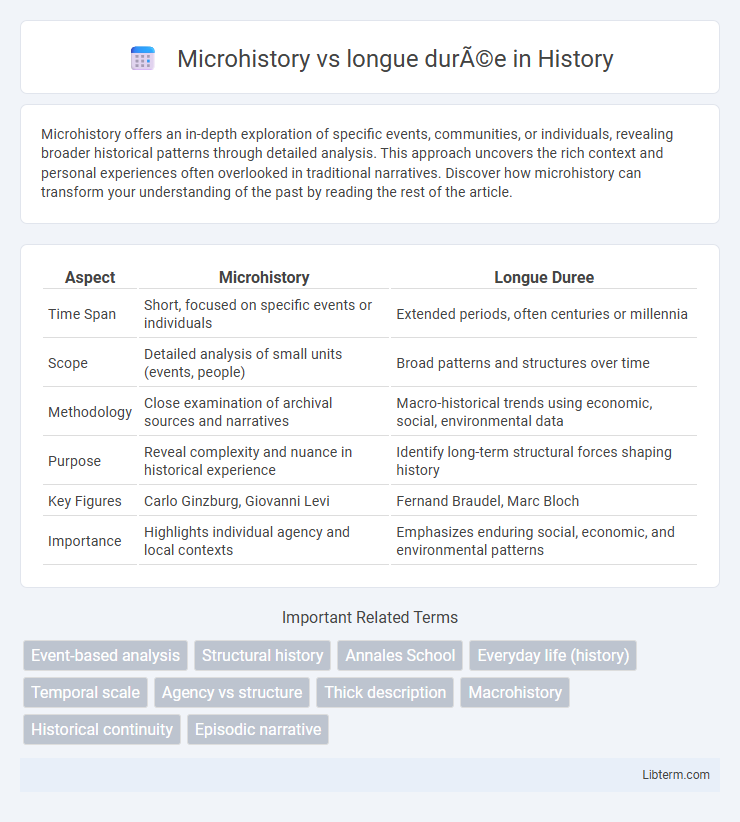Microhistory offers an in-depth exploration of specific events, communities, or individuals, revealing broader historical patterns through detailed analysis. This approach uncovers the rich context and personal experiences often overlooked in traditional narratives. Discover how microhistory can transform your understanding of the past by reading the rest of the article.
Table of Comparison
| Aspect | Microhistory | Longue Duree |
|---|---|---|
| Time Span | Short, focused on specific events or individuals | Extended periods, often centuries or millennia |
| Scope | Detailed analysis of small units (events, people) | Broad patterns and structures over time |
| Methodology | Close examination of archival sources and narratives | Macro-historical trends using economic, social, environmental data |
| Purpose | Reveal complexity and nuance in historical experience | Identify long-term structural forces shaping history |
| Key Figures | Carlo Ginzburg, Giovanni Levi | Fernand Braudel, Marc Bloch |
| Importance | Highlights individual agency and local contexts | Emphasizes enduring social, economic, and environmental patterns |
Introduction to Microhistory and Longue Durée
Microhistory emphasizes detailed study of specific individuals or communities to reveal broader historical insights through close analysis of daily life and unique events. Longue duree focuses on long-term historical structures and socio-economic patterns that persist over centuries, prioritizing systemic forces over fleeting events. Combining microhistory and longue duree offers a comprehensive framework by linking individual experiences with enduring historical trends.
Defining Microhistory: Scope and Methodology
Microhistory focuses on detailed investigations of specific individuals, events, or communities, emphasizing depth over breadth within a limited temporal and geographic scope. Its methodology involves examining archival sources, personal narratives, and material culture to uncover nuanced social, cultural, and historical dynamics often overlooked in broader studies. By concentrating on particular case studies, microhistory reveals complex human experiences and challenges generalizations inherent in longue duree analyses.
Understanding the Longue Durée Perspective
The longue duree perspective emphasizes the analysis of historical structures and processes that persist over centuries, focusing on geography, social institutions, and economic systems rather than individual events. This approach contrasts with microhistory, which zeroes in on detailed, small-scale studies of specific people or communities to reveal broader historical insights. Understanding longue duree illuminates enduring patterns that shape historical change, offering a macro-historical framework essential for contextualizing microhistorical findings.
Origins and Historiographical Context
Microhistory originated in the 1970s as a historiographical approach that emphasizes detailed, localized studies to uncover the experiences of ordinary individuals, contrasting with the longue duree, which stems from the Annales School and prioritizes long-term structural trends and broad societal changes. The longue duree framework, developed by historians like Fernand Braudel, focuses on economic, geographic, and social factors that shape history over centuries, thereby challenging traditional event-based narratives. Microhistory engages deeply with archival sources to reveal complexity in small-scale events, providing nuanced insights that complement the expansive temporal perspective of the longue duree.
Key Figures in Microhistory and Longue Durée
Key figures in microhistory include Carlo Ginzburg, known for pioneering detailed case studies like "The Cheese and the Worms," and Natalie Zemon Davis, who emphasized cultural narratives in everyday lives. Fernand Braudel stands as a central figure in longue duree, advocating for analyzing historical structures and environmental factors over centuries rather than events. The contrast between Ginzburg's granular focus and Braudel's expansive temporal scope exemplifies the methodological divergence between microhistory and longue duree.
Comparative Analysis of Approaches
Microhistory delves into detailed, small-scale studies of specific individuals or events to reveal broader social and cultural patterns, emphasizing nuance and context. Longue duree examines extended historical periods, focusing on enduring structures and deep-rooted social, economic, and environmental factors shaping historical continuity. The comparative analysis reveals microhistory's strength in uncovering agency and contingency while longue duree offers comprehensive understanding of systemic forces and long-term change.
Case Studies: Microhistory in Practice
Microhistory emphasizes detailed case studies that uncover the complexities of individual experiences, revealing unique social dynamics often overlooked by broader historical analyses. Unlike longue duree, which examines long-term structures and broad trends, microhistory delves into specific events or communities to expose nuanced cultural and social factors. This approach provides a granular understanding of history through intensive investigation of singular cases, enriching the broader historical context.
Case Studies: Longue Durée Applications
Case studies in longue duree applications reveal patterns spanning centuries, emphasizing structural continuities over immediate events. These studies utilize extensive historical data to analyze social, economic, and environmental transformations, highlighting gradual shifts influencing culture and institutions. By contrasting with microhistory's focus on detailed individual narratives, longue duree case studies offer broad contextual insights critical for comprehensive historical understanding.
Strengths and Limitations of Both Approaches
Microhistory excels in uncovering detailed, localized perspectives often overlooked by broader narratives, revealing nuanced social dynamics within specific contexts. Its limitation lies in potential overgeneralization from limited cases, which may not represent larger historical trends. Longue duree strength is its ability to analyze enduring structures and long-term social, economic, and environmental patterns, but it can underplay short-term events and individual agency critical to understanding historical complexity.
Contemporary Relevance and Future Directions
Microhistory offers detailed insights into individual and local experiences, revealing nuances that broad analyses often overlook, which enrich contemporary debates in social sciences and humanities. Longue duree emphasizes structural and enduring trends over centuries, providing a framework to understand persistent patterns shaping modern societies. Future directions integrate microhistorical depth with longue duree's macro perspectives through digital humanities, enabling comprehensive analyses that inform policy-making and cultural understanding in a rapidly changing world.
Microhistory Infographic

 libterm.com
libterm.com